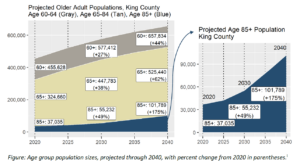Age Friendly Seattle: The Next Five Years

In 2016, Seattle joined the worldwide movement to make communities more conducive to aging. After earning our designation as an official age-friendly city, we launched Age Friendly Seattle (AFS) as a mechanism to operationalize our mission: to make Seattle a great place to grow up and grow old.
This goal continues to gain urgency. Like many places around the country, Seattle and King County are aging. Between 2020 and 2040, King County’s population of people aged 60 and above is projected to grow by 44 percent, from approximately 456,000 to 658,000. Within this, the number of older adults 85+ is expected to grow by an impressive 175 percent, representing our increased longevity. Because the likelihood of having a disability greatly increases with age, longer lives likely means more years lived with disabilities, begging questions about how our built environments will accommodate us.

Our older adult population is growing and will continue to do so past 2040. Click on the image above to open “Older Adult Health County Profile: King County,” a 2021 report prepared for the Washington State Department of Health, Washington State Dementia Action Collaborative, and Age-Friendly Public Health Systems.
In addition to becoming older, we are also increasingly diverse. While most of today’s Seattleites are white (66 percent), only 49 percent of people aged 18–24 are white. As younger generations age, older populations will likely become increasingly multiracial. One in five people between ages 65–74 in King County are foreign-born, as are nearly a quarter of those aged 75+, and approximately 13 percent of people over age 65 have limited English proficiency. Racial injustices can compound over a lifetime. Older adults of color in Seattle are more likely to experience economic insecurity and poor health than their white counterparts.
Local cities have many tools at their disposal to create communities where all people can age with ease. The housing and transportation environments we build today will have far-reaching impact on the aging populations of the future. We can prioritize racial equity in our programming and investments, reducing the wealth and health disparities people face in older years. As a citywide initiative, Age Friendly Seattle’s role is to ensure that the needs of older adults are recognized and prioritized. We do this by administering some of our own programs—such as age-friendly discounts and events—as well as by exercising our role as connector, convenor, advocate, and educator.
Our initial 2018–2021 Action Plan ambitiously tackled all eight of the World Health Organization’s domains of livability. Of the 87 action items contained in this plan, we are proud to have advanced 68—a considerable accomplishment amidst a global pandemic. This included improving the age-friendliness of Seattle’s streets, promoting Universal Design in homes, and holding regular, language-inclusive events at a time when access to information and social connection was critical.
As we look forward, our 2022–2027 Strategic Framework offers a roadmap for the next five years of Age Friendly Seattle’s efforts. It adopts a theory of change that believes older adults are able to thrive when they can enjoy continuity throughout the aging process, and that three key resources support continuity—financial, health, and social resources. Therefore, our framework is oriented around helping older adults retain their economic security, good health, and social connectivity. It contains 16 distinct goals and 44 related strategies and is intentionally designed to recognize the intersectionality of issues impacting older adults.
Rather than dictate each action we will take, the intent is to provide guidance for the prioritization of efforts over the next five years (potential actions are offered as examples only). Almost all of our proposed strategies require the partnership and involvement of other people and organizations.
We hope to benefit all Seattleites, and we also understand that racial and systemic injustices compound over a lifetime. For this framework, we challenged ourselves to identify race and social justice considerations related to each one of our goals. These considerations do not reflect a complete or definitive list but serve as touchstones to ensure equity is at the forefront of our minds when determining allocation of time and resources.
As 2020 taught us, being adaptive and nimble is important. The 2022–2027 AFS Strategic Framework provides guideposts while allowing room for ongoing discovery of new ways to make Seattle a friendlier place to age. Three years into the United Nation’s 2021–2030 Decade of Healthy Ageing, we are honored to continue pursuing Seattle’s commitment to making our community a place where people of all ages can thrive.
 Contributor Dinah Stephens manages the Age Friendly Seattle initiative. Read more about Age Friendly Seattle programs in this issue of AgeWise King County. E-mail agefriendly@seattle.gov or visit www.seattle.gov/agefriendly for more information.
Contributor Dinah Stephens manages the Age Friendly Seattle initiative. Read more about Age Friendly Seattle programs in this issue of AgeWise King County. E-mail agefriendly@seattle.gov or visit www.seattle.gov/agefriendly for more information.
![AgeWise King County [logo]](https://www.agewisekingcounty.org/wp-content/themes/agewisekingcounty/images/logo.png)